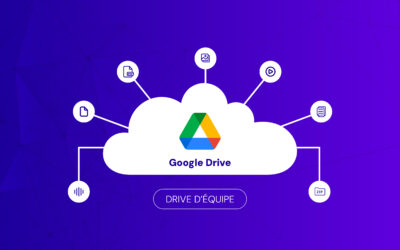Shared Google Drives, formerly known as Google Team Drives, are a valuable tool for businesses of all sizes looking to improve collaboration, file management and productivity.
In this article, we'll explore the key features of Shared Drives and provide tips for optimizing their use within your organization, drawing on insights from industry experts and real-life case studies.
What is a shared Drive?
A shared Drive is a feature of Google Workspace (formerly G Suite) that enables organizations to securely store, share and collaborate on files.
Unlike individual Google Drives, where files are usually owned by a single user, files in a shared Drive belong to the team or organization and are accessible to all authorized members.
This fosters a collaborative environment where team members can work together seamlessly on projects, regardless of their physical location.
Create a Shared Drive
Before you can use a shared Drive, you need to create one.
Here's how to do it:
- Open Google Drive: click on "Shared Drives" in the left-hand menu.
- Create a new shared Drive: Click on the "+" button next to "Shared Drives" to create a new shared Drive.
- Name your shared Drive: Give your shared Drive a name and click "Create".
- Initial setup: You now have a shared Drive ready for use by your team.
Add Members and Define Permissions
To give your team access to the shared Drive, you need to add members and define their permissions.
Follow these steps:
- Open your Shared Drive: Click on your new Shared Drive to open it.
- Add members: Click on the "Members" icon in the top right-hand corner of the screen, then click on "Add members" and enter the email addresses of the people you wish to add.
- Set permissions: Choose from the following options for each member: "Viewer", "Commentator", "Contributor" or "Manager".
- Invite members: Click "Send" to invite selected members.
They will receive an e-mail notification and will be able to access the shared Drive according to the permissions you have assigned.
Collaborate on Documents
Shared Drives facilitate real-time collaboration on documents, spreadsheets and presentations.
To work together on a file, follow these steps:
- Add or create a file: Drag and drop the file into the Shared Drive, or create a new file by clicking on "New" in the top left-hand corner.
- Open the file: Click on the file to open it.
- Work simultaneously : Other members can now open the file and start working on it simultaneously.
- Use collaboration features: Use comments and suggestions to communicate with team members and make changes to the document.
- Version history : Changes made to the file are automatically saved, and previous versions can be viewed by clicking on "Version history" in the "File" menu.
This allows you to track changes and return to earlier versions if necessary.
Organizing and searching files
To optimize file organization in shared Drives, it's crucial to use folders and subfolders to categorize your documents.
Here are a few tips to help you keep your files organized:
- Create structured folders: Create folders for each project, department or document type.
- Use sub-folders: further organize files according to your organization's specific needs.
- Add descriptions: Add descriptions to folders to provide more context for team members.
- Rename files consistently: Use a consistent naming convention for files to make them easier to search and identify.
- Use the search function: Shared Drives' integrated search function lets you quickly find files by entering keywords, file names or specific content.
You can also use filters to refine search results.
Permissions and Access Controls
Permissions and access controls are essential to ensure the security and confidentiality of your company's files on shared Drives.
They enable you to control who can access files and folders, and what actions team members can perform.
Here's an overview of the different permission levels and how to manage them:
Permission levels
There are five levels of permission in shared Drives:
- Viewer: Members with this permission level can view, comment on and download files, but cannot modify them or add/delete files.
- Commentator: Commentators have the same permissions as viewers, but can also add comments and suggestions to files.
- Contributor: Contributors can add, modify and delete files, but cannot manage members or change Shared Drive permissions.
- Content manager: Content managers have total control over the shared Drive, including managing members, modifying permissions and deleting files and folders.
- Manager: By adding a "Manager" permission level, you can ensure even more precise and secure management of your Shared Drive.
This helps ensure that only the appropriate users have the ability to change critical settings and oversee overall Shared Drive usage within your organization.
Access Permission Management
To change access permissions to a shared Drive, follow these steps:
- Modify permissions: Open Shared Drive, click on the "Members" icon, then click on the pencil icon next to the member's name to modify their permissions.
- Set specific permissions: Right-click on a file or folder, select "Share", then add specific people or groups and set their permission levels.
Data security and backups
Data security is a major concern for businesses, and Shared Drives offer several features to protect your files and information:
- Encryption: Google encrypts data stored in Shared Drives, both in transit and at rest, using industry-standard encryption protocols.
- Two-factor authentication: Enabletwo-factor authentication to add an extra layer of security when logging into Google Workspace.
This ensures that team members need to provide additional proof of identity before accessing files. - Version history : Shared Drives automatically retain previous versions of files, making it easy to restore an earlier version in the event of accidental modification or deletion.
To access the version history, click on "Version history" in a document's "File" menu. - Backups: Although Google ensures the security and redundancy of data stored on Shared Drives, it is recommended that you implement additional backups to protect your files from accidental deletion, corruption or malicious attacks.
You can use third-party services or in-house solutions to perform regular backups of your data.
Best Practices and Tips for Using Shared Drives Effectively
To maximize the benefits of Shared Drives in your organization, consider implementing these best practices and tips:
- Establish clear naming conventions: Develop a consistent naming system for shared drives, folders and files to ensure easy navigation and searching.
- Use descriptive folder structures: Organize files into well-structured folders and sub-folders that reflect your team's workflow and projects.
- Exploit comments and suggestions: Encourage team members to use comments and suggestions in documents to provide feedback, ask questions and collaborate effectively.
- Regularly review and update permissions: Perform periodic audits and adjust member permissions to maintain data security and control access to sensitive information.
- Train your team: Offer training sessions or resources to help your team members understand the features and benefits of Shared Drives and use them effectively.
-
Integrate with other Google Workspace tools: Seamlessly integrate Shared Drives with other Google Workspace applications, such as Google Meet, Google Chat and Google Calendar, to streamline the
communication and collaboration.
- Monitor storage usage: track storage usage in your shared Drives to avoid exceeding quotas and ensure optimum performance.
- Use third-party applications and add-ons: Explore third-party applications and add-ons that can extend the functionality of Shared Drives and enhance your team's productivity.
Examples of Shared Drives in action
Here are just a few examples of how companies in various sectors are using Shared Drives to improve collaboration and streamline workflows:
- Marketing teams: collaborate on marketing campaigns, share assets and track project deadlines.
- Sales teams: Store and share sales presentations, proposals and customer data.
- Project management teams: Manage project documentation, track tasks and communicate with stakeholders.
- Human resources departments: Store and share employee induction documents, company policies and performance appraisals.
- Educational institutions: Facilitate collaboration between students and teachers on group projects, research papers and lesson plans.
These examples demonstrate the versatility and adaptability of Shared Drives for diverse use cases and business needs.
Summary
Shared Drives are a powerful tool that can help companies improve collaboration, file management and productivity.
By understanding the key features of Shared Drives and following the best practices outlined in this article, you can optimize their use within your organization and foster a more efficient, collaborative working environment.
Whether you're a small business or a large corporation, Shared Drives can help you streamline workflows, improve data security and enable your team to work together seamlessly.
Embrace the power of Shared Drives and unlock new levels of collaboration and productivity within your organization.



